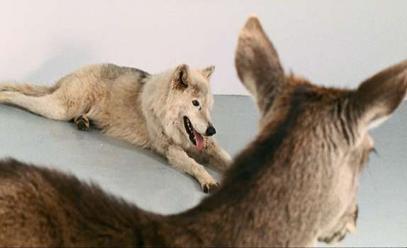Mircea Cantor
dal 16/9/2005 al 11/10/2005
Segnalato da
16/9/2005
Mircea Cantor
Yvon Lambert (old location), New York
Deeparture. The artist transforms the gallery into an indoor lunar landscape, including the print that Neil Armstrong's boot left on the surface of the moon. The viewers will find themselves transported into this archetypal image of the modern age and the Cold War. The artist brings the frozen image of a collective memory into our lives, allowing us to reflect on the passage of time and providing the scenery of a faraway place from which to look at ourselves.

For his first exhibition in New York Deeparture, Romanian born artist Mircea Cantor
has, with his piece The Second Step, 2005, transforms the gallery into an indoor
lunar landscape, including the print that Neil Armstrong's boot left on the surface
of the moon as he became the first person to step on our only satellite. Upon
entering the exhibition space the viewers will find themselves transported into this
archetypal image of the modern age and the Cold War, the milestone event that in
1969 was hailed as the greatest feat ever tackled by humankind.
By today the first moon landing seems an almost senseless endeavor; its promise of
unbound planetary exploration and colonization has not yet been fulfilled, and most
of us don't feel much closer to outer space than people did back then. Cantor seems
to draw on that frustration, providing the gallery goer with a tangible alternative
that bypasses the constraints of space agency budgets. Using concrete, the humble
material over which we travel on our everyday walks, the artist brings the frozen
image of a collective memory into our lives, allowing us to reflect on the passage
of time and providing the scenery of a faraway place from which to look at
ourselves.
The rest of the exhibition is literally viewed from the platform of this distance.
The two landscapes woven together in 2012, 2005 seem to signal the beginning and end
of a day, but sunrises and sunsets are notoriously difficult to differentiate. It is
also difficult to realize that one of these photographs was taken in Massada,
Israel, and the other one was taken by the NASA’s Mars Exploration Rover Spirit on
May 19, 2005. The apparently innocent displacement of time and space that occurs in
this work is nevertheless quite incisive, effectively merging the blue and red
planets into one image. As the artist states: "time loses its power when is
shown through static image, then an image can be sunset or sunrise depending how you
relate to it. As a sunrise is a sunrise ONLY when you participate in real life to
it.â€. As in previous pieces, Cantor blurs the distinction between here and there,
emphasizing the similarities of images, places and situations, rather than capitali
zing on their differences.
The gallery will be hosting a discussion between Mircea Cantor and Israel Rosenfield
on September 17th, from 5pm - 6pm. A cocktail reception will follow.
Israel Rosenfield writes frequently for The New York Review of Books and teaches
history at the City University of New York. He is the author of a number of
nonfiction books: Freud’s Megalomania (2000). The Strange, Familiar, and Forgotten:
An Anatomy of Consciousness (1992), The Invention of Memory: A New View of the Brain
(1988).
Yvon Lambert
564 West 25th Street New York, NY 10001
Tuesday-Saturday 10-6pm



